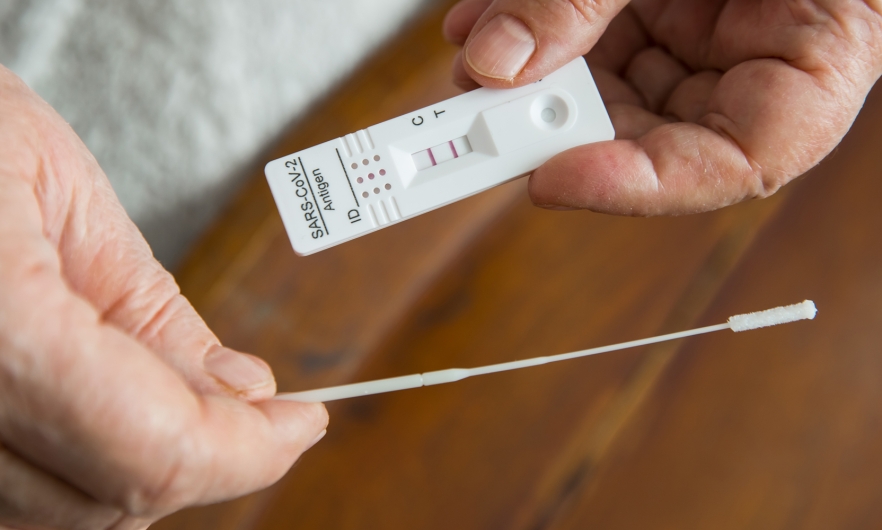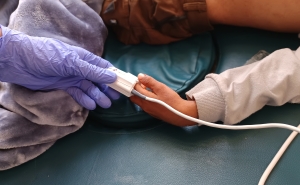What to Know About the EG.5 Variant
The new variant is a reminder that COVID-19 still poses a risk to public health.

The latest COVID-19 variant to make headlines, EG.5, is now the most prevalent variant in the U.S.—accounting for more than 17% of cases. Its high transmissibility and ability to evade immunity has virologists like Andrew Pekosz, PhD, professor in Molecular Microbiology and Immunology, following it closely.
Here, Pekosz explains EG.5’s role in the mid-year spike in cases, what precautions to take to protect yourself, and why the new vaccine—set for release this fall—will offer better protection than previous versions.
What is EG.5?
EG.5 is a recent COVID variant very closely related to the XBB variants that have been circulating here in the U.S. for the past six months. Notably, it contains one particular mutation that is known to evade some of the immunity that you get after an infection or vaccination.
What distinguishes it from other variants?
Besides the [genetic] sequence of the virus, it has been tracked recently to be associated with a rather fast increase in case numbers. It’s important to note that, while it’s increasing quickly, the total case numbers are still pretty low and pretty reasonable. We’re not talking about a potential surge similar to what we saw when omicron first emerged. But anytime we see a virus causing a rapid increase in cases, we always want to pay attention.
What symptoms are associated with EG.5?
EG.5 has been detected in the U.S. recently, but the data we have gleaned from the global circulation of the virus has shown that its symptoms are the same as other variants. Its disease potential appears to be exactly the same as other variants’ as well. The antivirals currently available should work against it. And the diagnostic tests, both the at-home rapid tests as well as tests that you get at medical facilities, all should recognize this variant quite well.
We're seeing a mid-year spike of COVID cases here in the U.S., as we have for the past three years. Is this a result of EG.5, low population immunity, or both?
While EG.5 is increasing faster than other variants, infections with other variants are also there. I think some of this increase is probably driven by waning population immunity. It's been quite a long time since boosters were provided for COVID, and those boosters did have a relatively low uptake rate in the population. That, combined with the fact that the XBB variants look different to your immune system from the [variants used in] previous COVID vaccines, means there's probably a lot of susceptible individuals in the population, and therefore these new variants are able to find new people to infect a little more easily than they have in the last couple of months.
What are you expecting to see with EG.5 as we head into fall? Is this a variant we should be really concerned about?
I think for the general population, this variant shouldn’t be of high concern. But it's an important reminder for those parts of the population that are susceptible to severe COVID-19—the elderly, those with medical conditions that predispose them to severe COVID—that you should think about how you're going to get tested and where the antivirals are available.
If you do start to suffer respiratory symptoms, don't dismiss them right away. Go out and get a COVID test. While they're not free anymore, the at-home tests are available in pharmacies. It would be great if everyone had them at home just to rule out COVID, particularly if you're in that vulnerable population. The faster you identify whether it's COVID or not, the faster you can get the treatments shown to reduce the rate of severe COVID.
Will existing vaccines protect against EG.5?
One of the fortunate things about EG.5 is that it's closely related to XBB variants, and the XBB variants are the basis for the new COVID vaccine that will be rolled out in the fall. There should be a nice match between that vaccine and the EG.5 variant, as well as the other XBB variants that are circulating right now.
Should you hold out for the new one if you’re due for a COVID vaccine now?
I think it's probably best if individuals wait and try to get in line right when that new fall vaccine rolls out so that they can have better protection against the currently circulating viruses.
What other precautions should we be taking? Is it time to mask up again?
Case numbers aren't as high as when we had to put into place some public health interventions. But, if you're in a high-risk group in particular, you might consider wearing a mask or social distancing a little bit more.
I would view this as a reminder that COVID is around—and COVID is still dangerous.
Morgan Coulson is an editorial specialist in the Office of External Affairs at the Johns Hopkins Bloomberg School of Public Health.





